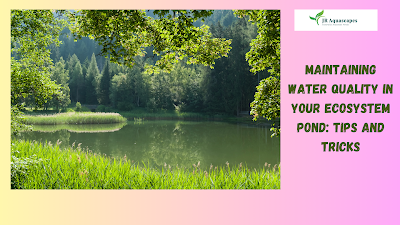Maintaining Water Quality in Your Ecosystem Pond: Tips and Tricks
A healthy ecosystem pond requires balanced water quality to support aquatic life. Poor water quality can lead to issues like algae blooms, disease outbreaks, and even fish kills.
By taking steps to maintain key parameters, you can keep your pond environment thriving. This article provides tips and tricks for preserving water quality in your backyard oasis. It can help you in pond maintenance without much of a stretch.
Maintaining suitable water quality involves keeping nutrients, gases, and other parameters within acceptable ranges. This provides conditions for plants, fish, and microorganisms to flourish.
With proper pond design, plant selection, and routine care, you can maintain a stable aquatic environment. Read on for insights into preserving water quality for a healthy ecosystem pond.
Tips for Maintaining Water Quality
- Pond Design and Setup
Proper pond design lays the foundation for healthy water quality. Consider factors like:
- Depth- Deeper areas prevent freezing while shallow sections allow growth of aquatic plants. Shoot for 1-2 metres deep and 0.5 metres shallow.
- Shape- Irregular edges create a natural look and diverse habitats. Include bays, inlets and islands.
- Volume- More water dilutes waste products, thus, aim for 1000+ litres.
- Filtration- Incorporate pumps, filters and UV systems sized for your pond volume. External pressurised filters work well.
- Location- Position pond away from trees and on a slight slope for drainage. Receive 4-6 hours of sunlight.
With good design and setup, your pond will support the aquatic ecosystem. Investing in quality equipment prevents issues down the line.
- Proper Plant Selection
Aquatic plants oxygenate water, absorb nutrients and provide habitat. Include:
- Surface plants like water lilies to shade and oxygenate.
- Submerged plants like hornwort to filter nutrients.
- Marginal plants like iris to absorb nutrients and stabilise banks.
- Floating plants like frogbit to absorb excess nutrients and provide shade.
Avoid over planting. This is because too many plants can deplete oxygen at night. Shoot for 40-60% surface coverage. Proper plants will maintain balance in your pond.
- Fish Management
The fish population must align with the capacity of your pond. Overstocking causes water quality issues from excess waste. Consider:
Stock capacity- General rule is 1 inch of fish per 10 gallons of water.
- Fish size- Mix fast growing fish with slow growing species.
- Feeding- Feed minimal amounts 1-2 times daily. Uneaten food fouls water.
- Waste removal- Use nets to remove solid waste before it decomposes.
Closely managing fish inhibits waste buildup. Limiting populations and feeding prevents degraded water conditions.
- Regular Maintenance Tasks
Consistent pond maintenance preserves water quality by removing pollutants. Key tasks include:
- Skimming debris weekly or as needed. This removes leaves, dirt and other organics.
- Pruning plants monthly to prevent overgrowth. Discard excess plant matter.
- Cleaning filters monthly as per manufacturer instructions.
- Removing string algae and detritus during routine skimming.
- Partial water changes of 15-20% monthly or as needed. Replace with dechlorinated water.
Staying on top of debris removal, algae control and filtration upkeep provides stable water quality. Developing a maintenance routine tailored to your pond prevents issues.
Factors Affecting Water Quality
Many parameters influence ecosystem pond water quality including:
- Temperature- Ideal range is 18-25°C. Extreme cold or heat stresses organisms.
- pH- This measures acidity. Optimal pH is around 7. Fluctuations harm aquatic life.
- Ammonia and nitrites- Their presence indicates excess waste and harmful conditions.
- Nitrates- Too many feeds algae. Plants help reduce levels.
- Oxygen- Levels below 5 ppm impair life. Surface movement and plants oxygenate.
- Turbidity- Cloudy water indicates suspended sediment or algae.
Regular testing lets you monitor water quality and correct any imbalances. Typical freshwater aquarium test kits work well for ponds.
Advanced Water Quality Management Techniques
For enhanced water management, consider:
- Beneficial bacteria- Products with live bacteria bolster biological filtration to process waste.
- UV sterilisation- A UV system kills algae and sterilises water of microbes.
- Biofiltration- Constructed wetlands or bog filters uptake nutrients and pollutants.
- Aeration- Fountains and air pumps add oxygen and surface agitation.
- Live plants- Incorporate more plants into filters and the pond margins.
- Partial water changes- Drain 10-15% water monthly and replace to “reset” conditions.
Advanced techniques require investment. However, they allow you to take water quality to the next level.
Conclusion
Maintaining excellent water quality makes your ecosystem pond thrive with clear water, lush plants and vibrant wildlife. With proper design, plant selection, fish management and routine care, you can maintain the necessary parameters for a balanced environment.
Test water frequently and use advanced techniques as needed. With a bit of effort, your backyard pond will become a crystalline oasis and vibrant biome.
Nowadays, people mostly go through hectic schedules. Thus, maintaining their ecosystem ponds can be problematic for them.
Getting assistance from professionals for pond maintenance will be beneficial to you. With adequate knowledge, experience and tools, they can get the job done easily.




Comments
Post a Comment